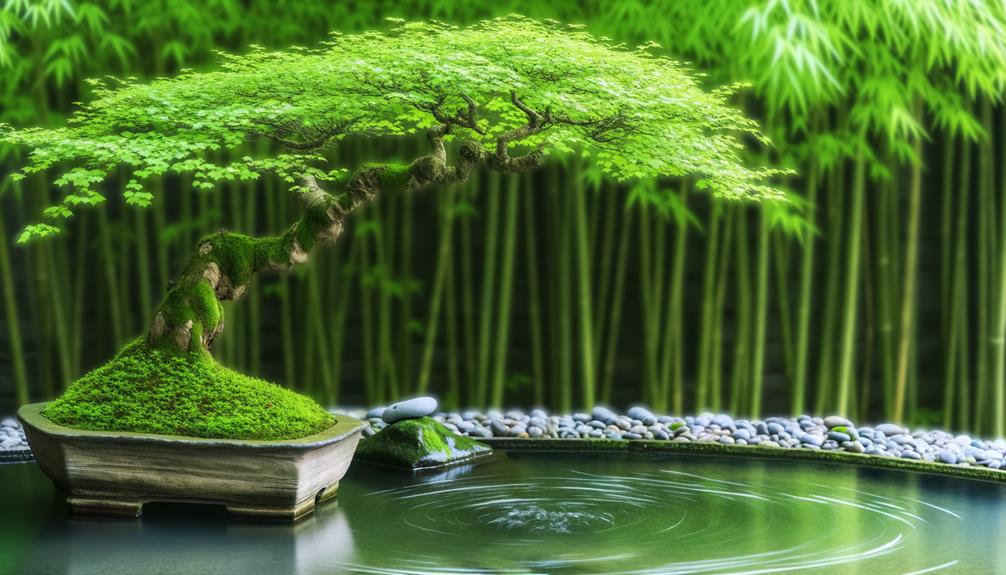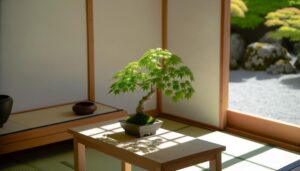Understanding the Chinese Elm Bonsai Tree Meaning and Care
The Chinese Elm bonsai tree carries profound cultural and philosophical significance. Originating during the Tang Dynasty, it symbolizes resilience and balance, as reflected in its adaptive growth and robust root system.
Embraced in classical gardens and Feng Shui, it channels harmony and positive energy. It also embodies good fortune, attracting prosperity and financial luck.
Cultivating this bonsai promotes patience, mindfulness, and creativity, making it a meaningful addition to any environment. Discovering its deeper symbolism and cultivation nuances can enrich one's appreciation for this remarkable tree.

Key Takeaways
- Represents resilience, balance, and longevity, reflecting its enduring strength and adaptability.
- Symbolizes harmony and balance, often used in Feng Shui to promote positive energy and equilibrium.
- Associated with prosperity and good fortune, believed to attract financial luck and abundance.
- Reflects personal growth, fostering patience, discipline, and mindfulness in its care and cultivation.
- Integral to classical Chinese gardens and art, symbolizing inner strength and graceful endurance.
Historical Significance

The historical significance of the Chinese Elm bonsai tree can be traced back to ancient China, where it was highly valued for its symbolism of harmony, inner strength, and flexibility.
Originating during the Tang Dynasty (618-907 AD), the practice of cultivating Chinese Elm bonsai was integral to the art of penjing—an ancient technique that predated Japanese bonsai.
The Chinese Elm, or Ulmus parvifolia, was meticulously shaped to reflect natural landscapes, embodying the principles of Daoism and Confucianism. Its resilience to pruning and adaptability to various climates made it a preferred species.
Historical texts and artworks reveal its prominence in scholarly gardens, where it was esteemed for both aesthetic appeal and philosophical connotations, serving as a tribute to the horticultural ingenuity of ancient Chinese culture.
Symbolism in Culture
Widely revered in both traditional and contemporary contexts, the Chinese Elm bonsai tree symbolizes resilience, balance, and longevity within various cultural paradigms.
In East Asian cultures, these trees are often integrated into classical gardens and art forms, representing harmony between nature and human intervention. The intricate process of shaping and maintaining a Chinese Elm bonsai reflects philosophical tenets such as patience and careful stewardship.
In Western interpretations, the tree is frequently seen as a representation of inner strength and adaptability. Its enduring leaves and robust structure offer a visual metaphor for enduring life's challenges gracefully.
Resilience and Strength

Embodying a remarkable tribute to nature's fortitude, the Chinese Elm bonsai tree showcases unparalleled resilience and strength through its adaptive growth patterns and enduring significance in varied environmental conditions. This species exhibits exceptional hardiness, thriving in diverse climates from temperate to tropical regions. Its robust root system anchors it firmly, enabling survival through adverse conditions such as drought and poor soil quality.
The Chinese Elm's ability to regenerate foliage after pruning highlights its adaptive resilience. Additionally, its dense, interwoven branches symbolize strength and fortitude, making it a powerful representation of enduring perseverance. The tree's capability to withstand and flourish amidst challenges underscores its esteemed role in horticulture and as a living attestation to resilience and strength.
Harmony and Balance
The Chinese Elm Bonsai holds profound symbolism in Eastern culture. It is often seen as a representation of harmony and balance due to its elegant and symmetrical form.
Its integration into Feng Shui practices further accentuates its significance. It is believed to channel positive energy and create a tranquil environment.
This dual role underscores the tree's importance in promoting both aesthetic and energetic equilibrium in various settings.
Symbolism in Eastern Culture
In Eastern culture, the Chinese Elm Bonsai tree is often revered as a powerful symbol of harmony and balance, encapsulating the philosophical principles of Yin and Yang. This ancient philosophy emphasizes dualities in nature, such as light and dark, male and female, and the Chinese Elm's intricate structure embodies this duality.
The tree's robust trunk and delicate leaves represent strength and gentleness coexisting in equilibrium. Its ability to thrive in various conditions signifies resilience and adaptability, further reinforcing these core principles. The meticulous care required in bonsai cultivation mirrors the discipline needed to achieve internal and external harmony.
The Chinese Elm Bonsai tree stands as a living proof to the Eastern pursuit of balance and symmetry in life.
Feng Shui Benefits
Harnessing the intrinsic qualities of the Chinese Elm Bonsai, Feng Shui practitioners often place this tree strategically within spaces to cultivate an environment of harmony and balance.
The Chinese Elm, with its intricate branching and serene appearance, embodies Yin and Yang principles, making it an ideal candidate for Feng Shui applications.
Its placement in the wealth area (southeast) of a room can enhance financial stability, while positioning it in the health sector (east) promotes physical well-being.
The tree's meticulous care process fosters mindfulness, encouraging a deeper connection with one's surroundings.
The evergreen nature of the Chinese Elm represents constant growth and resilience, reinforcing positive energy flow and providing a tranquil, balanced atmosphere within both residential and commercial spaces.
Good Fortune

The Chinese Elm Bonsai is revered not only for its aesthetic appeal but also for its association with good fortune. Traditionally, it is considered a symbol of prosperity, believed to attract positive energy and enhance financial luck for its caretaker.
This cultural significance underscores its popularity in homes and offices, where it serves as both a decorative element and a talisman for success.
Symbol of Prosperity
Renowned for its resilience and enduring strength, the Chinese Elm Bonsai is often seen as a powerful symbol of prosperity and good fortune.
This tree's ability to thrive under diverse conditions reflects the determination needed to achieve financial success and stability.
Its intricate, interwoven branches symbolize the intricate pathways to wealth, while its lush canopy represents abundance.
In the art of Feng Shui, the Chinese Elm Bonsai is believed to attract prosperity through its harmonious energy, fostering an environment conducive to growth.
Cultivating this bonsai requires patience and dedication, qualities that are also essential in the pursuit of prosperity.
Therefore, the Chinese Elm Bonsai stands as a living proof to the virtues of perseverance and meticulous care in achieving lasting affluence.
Attracting Positive Energy
Because of its well-proportioned and harmonious growth patterns, the Chinese Elm Bonsai is highly regarded in Feng Shui for its capacity to attract positive energy and good fortune into its surroundings. This small-scale tree, with its intricate network of branches and abundant foliage, serves as a powerful symbol of stability and peace. Its presence can improve the flow of Qi (energy) within a space, nurturing a tranquil and revitalizing atmosphere.
- Elegant, curving branches: Symbolize resilience and adaptability.
- Abundant, verdant leaves: Represent liveliness and development.
- Neat form: Conveys strength and rootedness.
- Evenly distributed foliage: Ensures harmonious energy flow.
- Sophisticated, textured bark: Adds a hint of natural beauty and refinement.
The Chinese Elm Bonsai thus becomes a living proof of nature's ability to nurture positivity.
Enhancing Financial Luck
Building on its ability to foster positive energy and tranquility, the Chinese Elm Bonsai is also reputed for its potential to enhance financial luck, making it a cherished asset in both personal and professional spaces.
Within the principles of Feng Shui, this bonsai is believed to attract prosperity and abundance. Its intricate, yet resilient structure symbolizes strength and perseverance, attributes essential for financial success.
When strategically placed in wealth corners or business environments, the Chinese Elm Bonsai is thought to activate monetary flow and fortify financial stability. By incorporating this bonsai into one's surroundings, individuals aim to create an atmosphere conducive to financial growth and sustained wealth, thereby aligning with ancient traditions that emphasize harmony and fortune.
Care and Cultivation
Proper care and cultivation of the Chinese Elm Bonsai demand meticulous attention to watering, pruning, and positioning to secure growth and aesthetic appeal. This resilient species thrives best under specific conditions, requiring certain practices to maintain its health and beauty.
- Watering: Maintain the soil's consistent moisture levels without saturating it, adjusting as needed with seasonal changes.
- Pruning: Regular trimming is vital to shape the tree and promote vigorous growth, focusing on eliminating dead or overcrowded branches.
- Positioning: Place the bonsai in a spot that receives plentiful indirect sunlight; avoid drastic temperature changes.
- Soil: Use well-draining, nutrient-rich bonsai soil to promote root health and prevent compaction.
- Fertilizing: Apply balanced, slow-release fertilizer during the growing season to bolster robust foliage and root development.
These practices are essential for cultivating a thriving Chinese Elm Bonsai.
Feng Shui Connections

Incorporating a Chinese Elm Bonsai into one's living space can greatly enhance the flow of positive energy, or 'Chi,' aligning with key principles of Feng Shui to foster harmony and balance.
Strategically placing the bonsai in areas such as the east or southeast corners of a room can amplify its beneficial effects, as these locations are traditionally associated with health and prosperity.
The Chinese Elm's intricate branching and lush foliage symbolize growth and stability, promoting both physical well-being and mental clarity.
Additionally, its natural wood element integrates seamlessly with Feng Shui's five-element theory, helping to balance the energy map, or 'Bagua,' of the home.
Therefore, this bonsai serves as a powerful conduit for nurturing a tranquil and prosperous environment.
Personal Growth
Cultivating a Chinese Elm Bonsai fosters personal growth by instilling patience, discipline, and mindfulness through the meticulous care and attention required for its maintenance. The intricate process of bonsai cultivation demands a harmonious blend of art and science, encouraging a deep connection with nature and self-reflection. This endeavor nurtures various personal attributes:
- Patience: Observing the slow, deliberate growth of the bonsai tree.
- Discipline: Adhering to a regular schedule for watering, pruning, and shaping.
- Mindfulness: Focusing intently on the tree's needs and responses.
- Problem-solving skills: Addressing issues such as pests or nutrient deficiencies.
- Creativity: Designing aesthetically pleasing forms and structures.
These elements collectively contribute to a profound journey of self-improvement and inner peace.
Conclusion
The Chinese elm bonsai, with its deep historical roots and profound cultural symbolism, stands as a symbol of resilience and strength, embodying harmony, balance, and good fortune.
Its intricate care and cultivation mirror the meticulous journey of personal growth, while its connections to Feng Shui underscore its significance in fostering positive energy.
Like a tapestry woven with threads of tradition and meaning, the Chinese elm bonsai enriches both aesthetic and spiritual spheres, offering a timeless source of inspiration.






